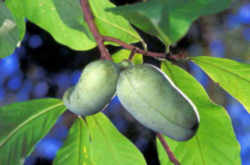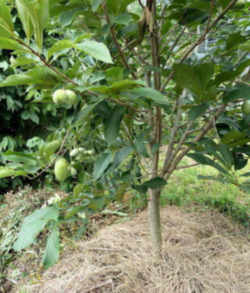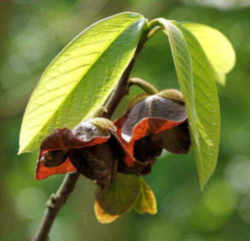Ohio State Native Fruit
Pawpaw

(Asimina triloba)
Adopted on January 6, 2009
In the past 20 years, a little-known fruit called the pawpaw has experienced a resurgence, with many Ohioans growing, selling and eating their own pawpaws. The pawpaw (Asimina triloba) is North America's largest native tree fruit and its trees are found throughout all of Ohio. According to fossil records, the papaw's forebears were established in North America millions of years before the arrival of humans. American Indians extensively used the pawpaw and introduced it to European explorers. The pawpaw has more protein than most other fruits, with a flavor somewhat similar to both banana and mango, which varies depending on cultivar. An annual festival in Athens County is devoted to the pawpaw, which was named Ohio state native fruit in 2009.
Gov. Ted Strickland made the pawpaw Ohio's native state fruit. State Senator Jimmy Stewart had proposed the pawpaw for recognition for the past
5 years, seeing it as a way to bring in tourists. The Ohio Pawpaw Festival will celebrate its 11th birthday this year.
The pawpaw wasn't a shoe-in, however. Senator Stewart originally proposed the pawpaw be the state's official fruit. That distinction went to the tomato
(which, strangely enough, is legally a vegetable , but botanically a fruit). Senator Stewart was able to use the pawpaw's native status to win the
official state recognition.
"With a texture comparable to an avocado's fruit and a taste that blends tropical flavors such as banana and mango, the pawpaw is native to 26 states,
according to the Kentucky State University pawpaw research program." In fact, the pawpaw is the only edible fruit that is native to Ohio.
Ohio State Fruit: Pawpaw

Asimina triloba, the pawpaw, paw paw, paw-paw, or common pawpaw, is a species of Asimina (the pawpaw genus) in the same plant family (the Annonaceae) as the custard-apple, cherimoya, sweetsop, ylang-ylang and soursop.
The pawpaw is native to the Eastern, Southern, and Midwestern United States and adjacent southernmost Ontario, Canada, from New York west to southeastern Nebraska, and south to northern Florida and eastern Texas.
The pawpaw is a patch-forming (clonal) understory tree found in well-drained, deep, fertile bottom-land and hilly upland habitat, with large, simple leaves and large fruits. The paw paw is the largest edible fruit indigenous to the United States
Characteristics of the Pawpaw

A member of the Annona family, the pawpaw tree grows throughout Ohio and produces fruit in the late summer. Pawpaws begin from dark lavender to purple-red flowers to ripen to yellow-brown fruits and can grow in clusters or singly. They provide food for both wild animals and humans. Pawpaw trees can grow up to 25 feet tall, and the crown of its branches can be up to 15 feet wide. They are distantly related to magnolias. Pawpaw trees rarely develop diseases or pests although they do have a somewhat weak root system that makes transplanting difficult
Growth Habit:
The pawpaw is a deciduous, often narrowly conical tree growing from about 12 feet to around 20 feet. Pawpaw trees are prone to producing root suckers a few feet from the trunk. When these are permitted to grow, the single-clone pawpaw patch comes into being. The prevailing experiences of many individuals is that the pawpaw is a slow grower, particularly when it is young. However, under optimal greenhouse conditions, including photo-period extension light of approximately 16 hours, top growth of up to 5 feet can be attained in three months.
Foliage:
The dark green, obovate-oblong, drooping leaves grow up to 12 inches long, giving the pawpaw an interesting tropical appearance. The leaves turn yellow and begin to fall in mid-autumn and leaf out again in late spring after the tree has bloomed.
Flowers:
Dormant, velvety, dark brown flower buds develop in the axils of the previous years' leaves. They produce maroon, upside-down flowers up to 2 inches across. The normal bloom period consists of about 6 weeks during March to May depending on variety, latitude and climatic conditions. The blossom consists of 2 whorls of 3 petals each, and the calyx has 3 sepals. Each flower contains several ovaries which explains why a single flower can produce multiple fruits.
Fruit:
The pawpaw is the largest edible fruit native to America. Individual fruits weigh 5 to 16 ounces and are 3 to 6 inches in length. The larger sizes will appear plump, similar to the mango. The fruit usually has 10 to 14 seeds in two rows. The brownish to blackish seeds are shaped like lima beans, with a length of 1/2 to 1-1/2 inches. Pawpaw fruits often occur as clusters of up to nine individual fruits. The ripe fruit is soft and thin skinned.
Ohio Law
The law designating the tomato as the official Ohio state native fruit is found in the Ohio Revised Code, General Provisions, Chapter 5, Section 5.081.
GENERAL PROVISIONS
CHAPTER 5: STATE INSIGNIA; SEALS; HOLIDAYS
SECTION 5.082
Sec. 5.082. The fruit, Asimina triloba, commonly known as the pawpaw, is hereby adopted as the state native fruit.
Taxonomic Hierarchy: Pawpaw
Kingdom: Plantae - Plants
Subkingdom: Tracheobionta - Vascular plants
Superdivision: Spermatophyta - Seed plants
Division: Magnoliophyta - Flowering plants
Class: Magnoliopsida - Dicotyledons
Subclass: Magnoliidae
Order: Magnoliales
Family: Annonaceae - Custard-apple family
Genus; Asimina Adans. - pawpaw
Species; Asimina triloba (L.) Dunal - pawpaw

List Official US State Foods







